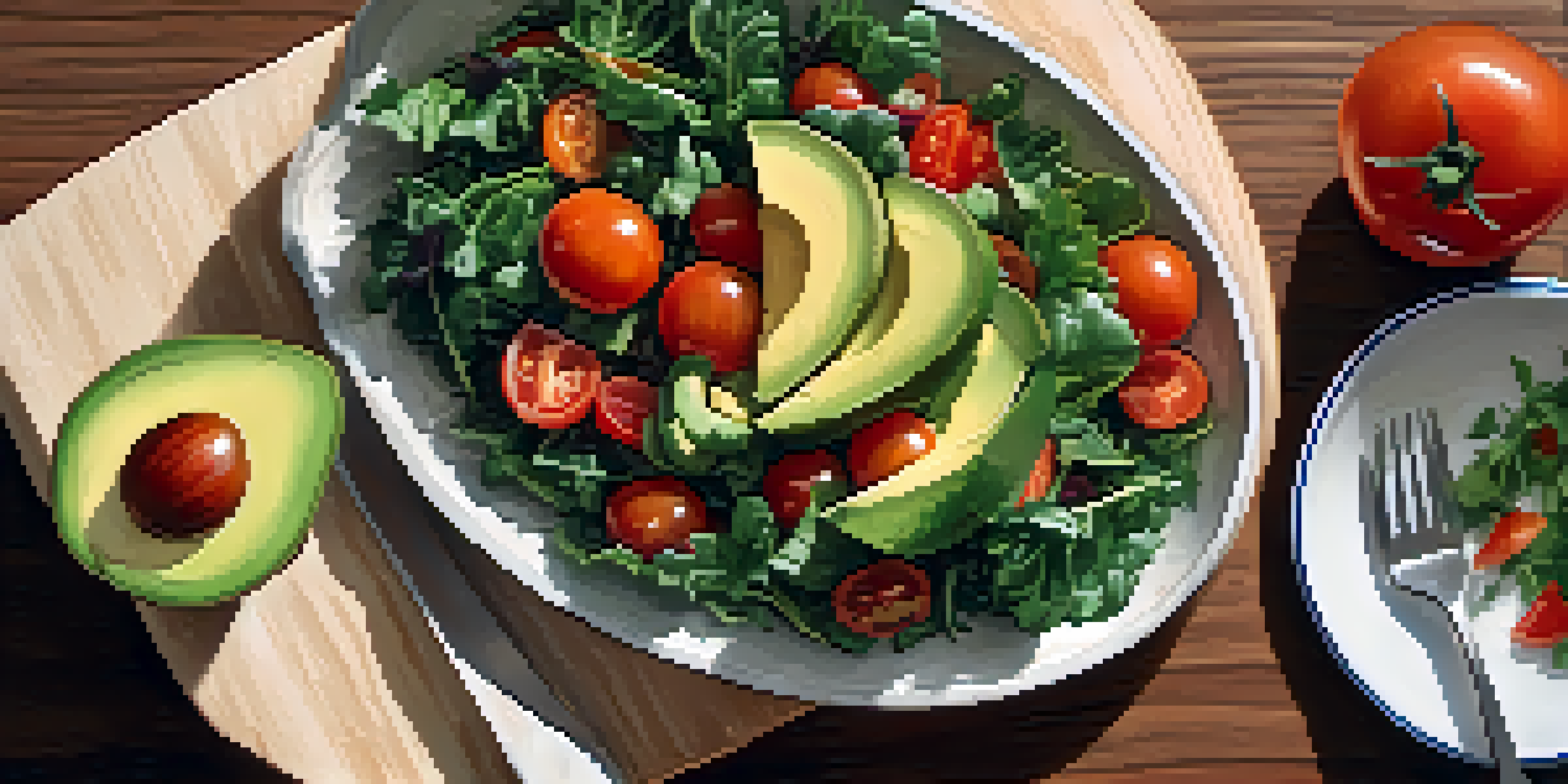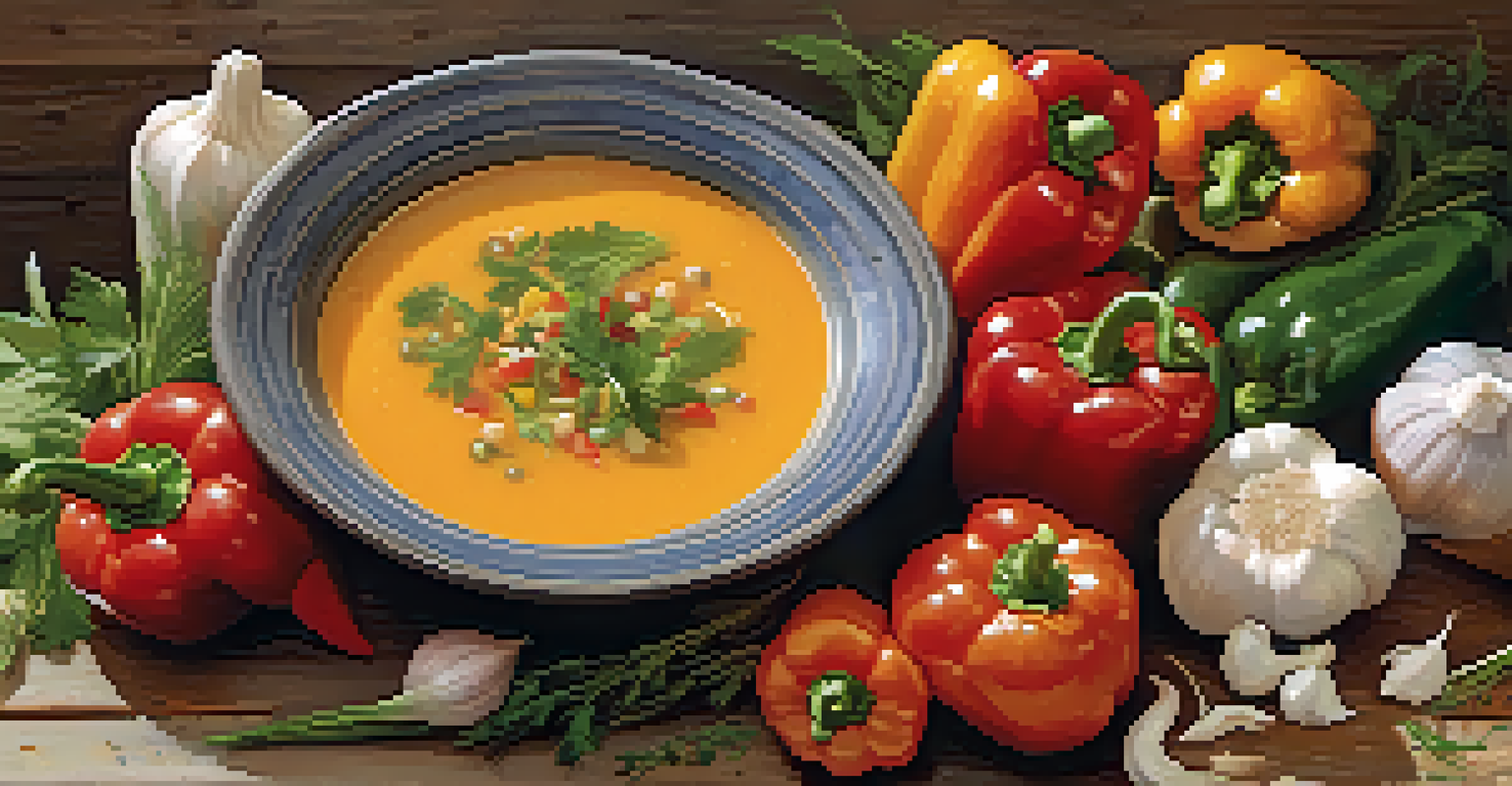10 Essential Tips for Stunning Vegetarian Food Photography

Choose Fresh and Vibrant Ingredients for Impact
The foundation of great food photography starts with the ingredients. Fresh, colorful vegetables and fruits not only taste better but also look stunning on camera. Think of vibrant bell peppers, deep green kale, or juicy tomatoes; these pops of color create a visual feast that draws the eye.
Food photography is about capturing the beauty of food in a way that invites the viewer to enjoy it with all their senses.
When selecting your ingredients, aim for variety. Mixing textures and colors not only adds interest but also tells a story about the dish. For instance, pairing smooth avocado with crunchy nuts can create an appealing contrast that invites viewers to explore the dish further.
Don’t hesitate to use seasonal produce to enhance your photos. Seasonal ingredients not only taste better but also reflect the time of year, adding a relatable touch to your food photography. Imagine capturing a bowl of autumn squash soup or a summer salad bursting with fresh herbs and tomatoes.
Natural Lighting: Your Best Friend for Food Photography
When it comes to food photography, natural light is your best ally. Soft, diffused sunlight illuminates your dish beautifully, enhancing colors and textures without harsh shadows. Positioning your setup near a window can make a world of difference.

Avoid direct sunlight, as it can create unpleasant glare and overly bright spots. Instead, look for indirect light or use sheer curtains to soften the harsh rays. This creates a warm and inviting atmosphere that complements your vegetarian dishes.
Fresh Ingredients Make Impact
Using vibrant, seasonal ingredients enhances both the taste and visual appeal of your food photography.
Experimenting with different times of day can also yield stunning results. Early morning or late afternoon light often provides a golden hue that adds warmth to your images, making your dishes look even more appetizing.
Composition: The Art of Arranging Your Dish
Composition is crucial in food photography as it guides the viewer's eye. One popular technique is the 'rule of thirds,' where you divide your frame into nine equal parts and place your main subject along those lines or at their intersections. This creates a balanced and visually appealing image.
You don’t take a photograph, you make it.
Additionally, consider layering your ingredients to create depth. For example, stack slices of vegetables or arrange herbs in a way that leads the eye through the photograph. This not only showcases the dish but also adds a dynamic quality to your images.
Don’t forget the negative space! Allowing some space around your dish can help highlight it and make it stand out even more. It’s like giving your food room to breathe, creating a more polished and professional look.
Use Props to Enhance Your Food Story
Props can elevate your food photography by adding context and telling a story. Think about incorporating utensils, cutting boards, or vibrant linens that complement your dish. These elements can create a narrative and make your images feel more inviting.
However, it's essential to strike a balance. Too many props can distract from the main event—the food itself. Aim for simplicity and choose items that enhance the overall aesthetic without overwhelming the viewer.
Natural Light is Key
Soft, natural light enhances colors and textures, creating a warm and inviting atmosphere for food images.
Remember, every prop should serve a purpose, whether it’s adding color, texture, or context. A rustic wooden board beneath a colorful salad can evoke a sense of home and warmth, making your vegetarian dishes even more appealing.
Experiment with Angles for Unique Perspectives
The angle at which you shoot can dramatically change the feel of your food photography. A top-down shot is great for capturing flat lay compositions, while a 45-degree angle can showcase the layers and textures of a dish beautifully. Don’t be afraid to experiment with different perspectives.
Sometimes, an eye-level shot can create a more intimate connection with the food, allowing viewers to feel as if they’re about to indulge in the dish themselves. Imagine taking a photo of a hearty vegetarian burger from eye level, capturing all the delicious layers inside.
Try to move around your food and explore various angles. You might find that an unexpected perspective reveals hidden details that enhance the image. The goal is to find what best showcases your dish and keeps the viewer engaged.
Editing: Enhance Your Photos Without Overdoing It
Editing is an essential step in food photography, allowing you to enhance colors and details while maintaining authenticity. Tools like Lightroom or Photoshop can help you adjust brightness, contrast, and saturation to bring your images to life.
However, it’s crucial to avoid over-editing, which can lead to unrealistic photos. Aim for a natural look that reflects the true beauty of your vegetarian dishes. A little adjustment can go a long way, highlighting the vibrant colors without altering the dish's essence.
Tell a Story with Your Photos
Great food photography captures not just the dish but also the emotions and experiences surrounding the meal.
Consider using presets for consistency across your photos. This can help create a cohesive aesthetic that reflects your personal style and brand. Just be sure to customize them to fit each specific image for the best results.
Tell a Story with Your Food Photography
Great food photography goes beyond capturing a dish; it tells a story. Think about the emotions and experiences associated with the meal. Is it a cozy family gathering, a vibrant summer picnic, or a quiet dinner for one? Incorporating elements that reflect this can enhance the narrative.
Consider featuring ingredients in their raw form alongside the finished dish. This can give viewers a glimpse into the preparation process and create a connection to the food. It’s like giving them a behind-the-scenes look at the culinary journey.

Ultimately, the story you tell through your photographs can engage your audience on a deeper level. It invites them to not just look at the food but to feel the moments and memories that come with it, making your vegetarian dishes even more appealing.